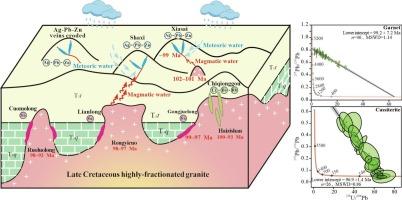宜敦地体晚白垩世锡矿床成因与岩浆作用:东南亚锡带进一步北伸及其勘探意义
IF 7.2
1区 地球科学
Q1 GEOSCIENCES, MULTIDISCIPLINARY
引用次数: 0
摘要
中国益墩地体位于世界著名的东南亚锡带(SATB)北部,具有大量Sn-Pb-Zn-Ag和Cu-Mo-W矿床的特征。锡矿化年龄的不明确阻碍了对近端锡矿化与远端铅锌银矿化之间时空和成因联系的认识。此外,依顿地体的锡矿化是否属于SATB向北伸展仍存在争议。具有代表性的公爵龙锡矿床新获得的石榴石和锡石U-Pb年龄(99 ~ 97 Ma)与邻近的铅锌银矿床年龄和海子山成因花岗岩新获得的锆石U-Pb年龄(~ 98 Ma)一致。全岩地球化学特征、锆石微量元素特征和负的εHf(t)值表明,海子山花岗岩为还原高分异的a型花岗岩,岩浆主要来源于古基底地壳的部分熔融。成矿流体为H2O-NaCl-CO2±CH4体系,流体H-O同位素表明初始成矿流体为岩浆成因,随着时间的推移,大气降水的输入逐渐增加。公爵龙锡矿床硫化物的S-Pb同位素值与晚白垩世花岗岩和铅锌银矿床硫化物的S-Pb同位素值相似。这些年代学、流体包裹体和同位素资料表明,益顿地体的成矿风格多样,构成了一个以晚白垩世花岗岩为中心的完整成矿体系,深部为近端矽卡岩型锡,上部为远端热液脉型铅锌银成矿。此外,依顿地体与南洋带经历了相似的构造岩浆史和成矿史,表明依顿锡带可被认为是南洋带的北伸展。该模型强调了在铅锌银矿床下可能存在隐伏的锡矿床,以及锡矿体和高分选花岗岩周围存在铅锌银矿脉和稀有金属矿化。本文章由计算机程序翻译,如有差异,请以英文原文为准。

Genesis of Late Cretaceous Sn deposits and magmatism in the Yidun Terrane, China: Further northward extension of the Southeast Asian Tin Belt and implication for exploration
The Yidun Terrane in China is located in the north of the world-renowned Southeast Asian Tin Belt (SATB) and is characterized by large numbers of Sn–Pb–Zn–Ag and Cu–Mo–W deposits. Understanding the spatiotemporal and genetic links between proximal Sn and distal Pb‒Zn‒Ag mineralization is hampered by the poorly defined Sn mineralization age. Additionally, it is still debatable if the Sn mineralization in the Yidun Terrane belong to the northward extension of the SATB. Newly obtained garnet and cassiterite U‒Pb ages (99–97 Ma) from the representative Gongjuelong Sn deposit are consistent with the ages of adjacent Pb‒Zn‒Ag deposits and new zircon U-Pb ages (∼98 Ma) of the causative Haizishan granites. The whole-rock geochemistry, zircon trace elements and negative εHf(t) values reveal that the Haizishan granites are reduced and highly-fractionated A-type granites, with the magmas mainly derived from the partial melting of old basement crust. The ore-forming fluids are of the H2O-NaCl-CO2 ± CH4 system, and the H–O isotopes of the fluids indicate that the initial ore-forming fluids were of magmatic origin with increasing input of meteoric water over time. The S-Pb isotope values of sulfides from the Gongjuelong Sn deposit resemble those of both Late Cretaceous granites and sulfides in the Pb‒Zn‒Ag deposits. These geochronological, fluid inclusion and isotopic data suggest that the diverse styles of mineralization in the Yidun Terrane constitute an integrated ore system centered on Late Cretaceous granites, consisting of proximal skarn Sn at depth and distal hydrothermal-vein-type Pb‒Zn‒Ag mineralization above. Furthermore, the Yidun Terrane and SATB underwent similar tectonomagmatic and mineralization histories, suggesting that the Yidun Sn belt can be considered as a northern extension of the SATB. This proposed model highlights the potential existence of concealed Sn deposits beneath the Pb‒Zn‒Ag deposits, as well as Pb‒Zn‒Ag veins and rare metal mineralization around the Sn orebodies and highly-fractionated granites.
求助全文
通过发布文献求助,成功后即可免费获取论文全文。
去求助
来源期刊

Gondwana Research
地学-地球科学综合
CiteScore
12.90
自引率
6.60%
发文量
298
审稿时长
65 days
期刊介绍:
Gondwana Research (GR) is an International Journal aimed to promote high quality research publications on all topics related to solid Earth, particularly with reference to the origin and evolution of continents, continental assemblies and their resources. GR is an "all earth science" journal with no restrictions on geological time, terrane or theme and covers a wide spectrum of topics in geosciences such as geology, geomorphology, palaeontology, structure, petrology, geochemistry, stable isotopes, geochronology, economic geology, exploration geology, engineering geology, geophysics, and environmental geology among other themes, and provides an appropriate forum to integrate studies from different disciplines and different terrains. In addition to regular articles and thematic issues, the journal invites high profile state-of-the-art reviews on thrust area topics for its column, ''GR FOCUS''. Focus articles include short biographies and photographs of the authors. Short articles (within ten printed pages) for rapid publication reporting important discoveries or innovative models of global interest will be considered under the category ''GR LETTERS''.
 求助内容:
求助内容: 应助结果提醒方式:
应助结果提醒方式:


